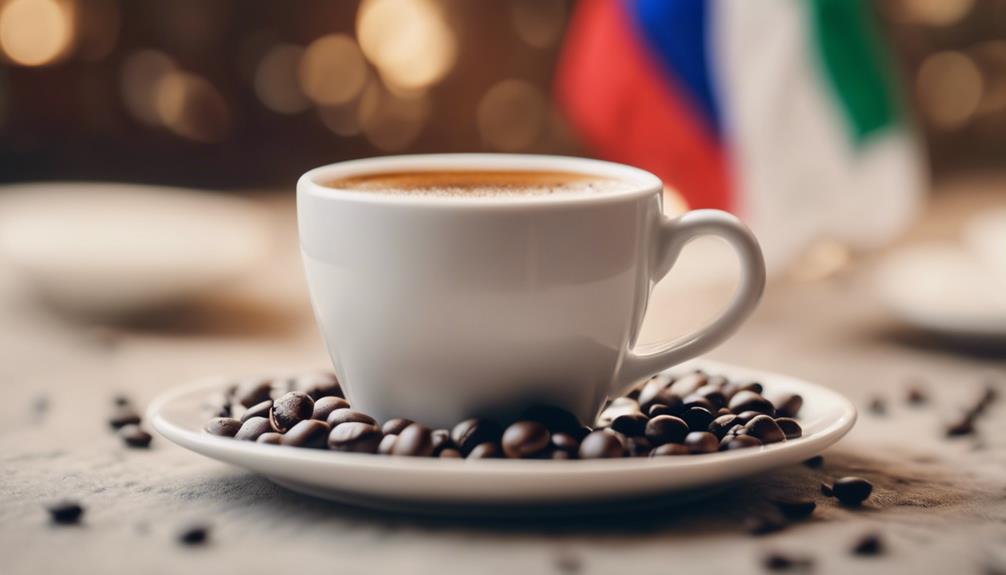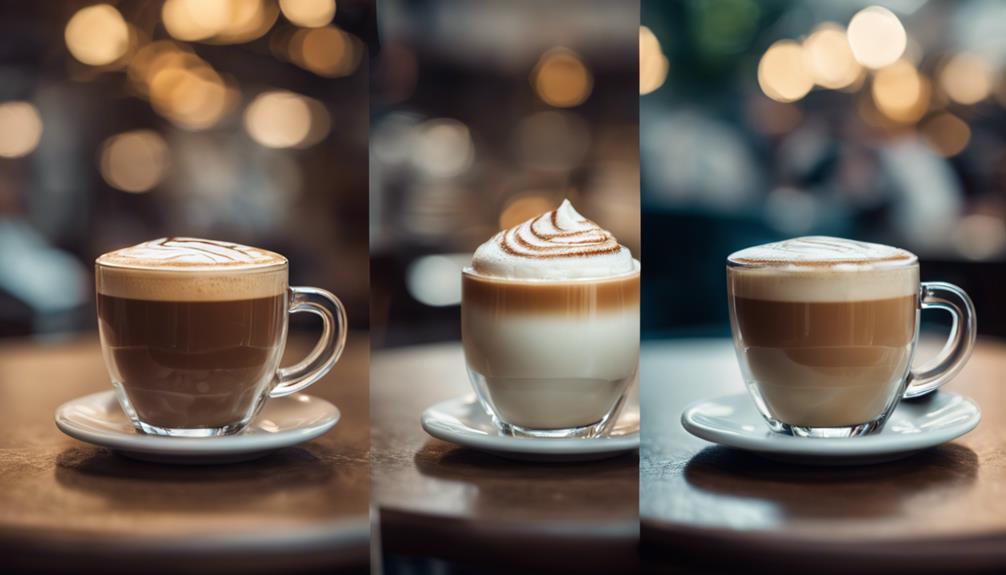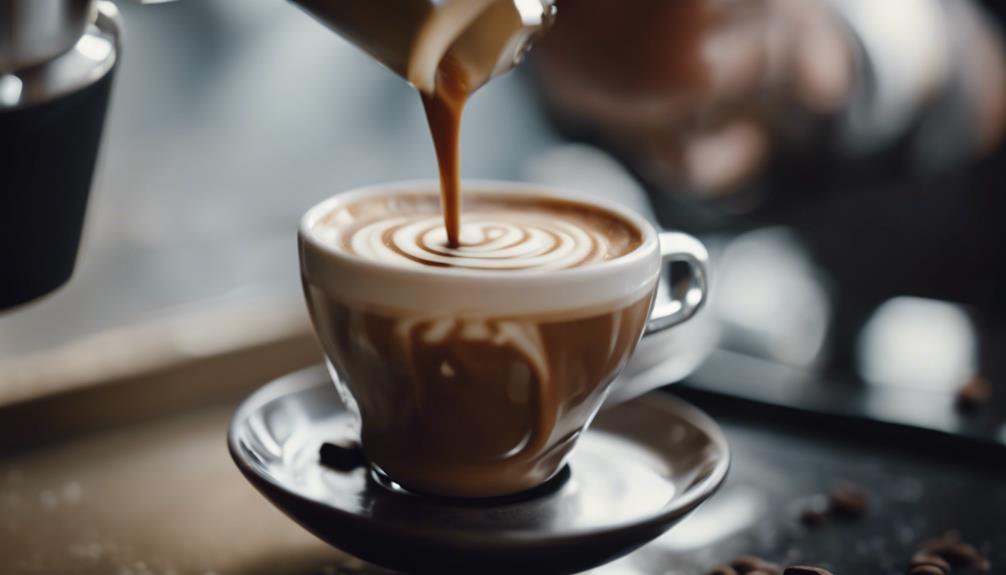In espresso culture, three beans represent health, wealth, and happiness, a tradition deeply rooted in Italian culture. These beans are believed to bring luck and prosperity, adding a layer of meaningful symbolism to the coffee drinking experience. For those interested in delving deeper into the significance of these three espresso beans, there is much to learn about their cultural origins and the values they embody.
Key Takeaways
- Represent health, wealth, and happiness in Italian culture.
- Associated with luck and prosperity, adding meaning to the Espresso Martini.
- Symbolize the Holy Trinity in Christianity, reflecting blessings.
- Hold deep cultural significance beyond aesthetics.
- Enrich the drinking experience with layers of auspicious symbolism.
Symbolism of Three Espresso Beans
When considering the symbolism of three espresso beans, it becomes evident that they hold significant meaning in the world of cocktail culture, specifically in the context of the Espresso Martini. These three coffee beans aren't just a mere garnish; they represent health, wealth, and happiness.
Rooted in Italian culture and tradition, the practice of adorning the cocktail with these beans adds a touch of elegance and auspicious symbolism.
In Italian culture, the number three holds special significance, often associated with luck and prosperity. By incorporating three espresso beans as a garnish, the Espresso Martini not only pays homage to its Italian roots but also infuses the drink with a sense of good fortune.
This blend of history, tradition, and mixology creates a rich tapestry of symbolism that elevates the cocktail experience to more than just a drink—it becomes a symbol of health, wealth, and happiness, all encapsulated in those three humble coffee beans.
Cultural Significance of Espresso Garnish

The cultural significance of the espresso garnish with three beans lies in its representation of health, wealth, and happiness in Italian cocktail traditions. When you make an Espresso Martini, those three beans on top aren't just for show; they carry deep symbolic meaning rooted in Italian culture. Here are some key points to take into account:
- The 3 bean garnish symbolizes the Holy Trinity in Christianity.
- Italian culture heavily influences the tradition of using three beans as a garnish in cocktails like Espresso Martinis.
- The historical roots of the 3 bean garnish reflect blessings and good luck.
- Each bean is said to represent health, wealth, and happiness, adding layers of meaning to your drinking experience.
- The cultural symbolism of the 3 bean garnish extends beyond just aesthetics, enriching the overall cocktail experience with auspicious symbolism.
The Meaning Behind Three Beans

The significance behind the three espresso beans in cocktails is deeply rooted in symbolism and cultural tradition. The tradition of using three beans as a garnish in drinks like Espresso Martinis carries profound meanings of health, wealth, and happiness. This practice stems from Italian culture, where the act of adding three beans reflects blessings, good luck, and overall prosperity. The elegance and cultural significance that the three beans bring to a drink go beyond mere decoration; they symbolize a fusion of history, culture, and mixology within the coffee community. This simple garnish is more than just a visual addition; it represents a deep connection to beliefs and values that enhance the drinking experience.
| Symbolism | Description |
|---|---|
| Health | Represents well-being |
| Wealth | Signifies prosperity |
| Happiness | Symbolizes joy |
| Blessings | Reflects good fortune |
| Good Luck | Brings positive outcomes |
Frequently Asked Questions
Why Are There Three Espresso Beans in Sambuca?
In Sambuca, the presence of three espresso beans holds cultural significance. These beans aren't mere decoration; they symbolize the Holy Trinity in Italian tradition.
By representing the Father, the Son, and the Holy Spirit, the three beans convey blessings of health, wealth, and happiness.
This practice of serving Sambuca with three beans is deeply rooted in ancient customs, believed to bring good luck and protect against malevolent spirits.
How Many Espresso Beans Equal a Coffee?
To make a cup of coffee, you typically need more than just three espresso beans. The amount of beans required varies based on the brewing method, coffee type, and personal taste preferences.
For a standard brewed coffee, a rough estimate is about 15-20 grams of coffee beans per 8 oz cup. Experimenting with bean quantities can help you find the perfect balance of flavor and strength in your coffee.
Do You Eat the Espresso Beans in an Espresso Martini?
Yes, you can eat the espresso beans in an Espresso Martini if you choose to. It's not necessary, but some people enjoy chewing and consuming them after sipping the cocktail.
This practice is a matter of personal preference and not a strict rule. Eating the espresso beans is believed by some to enhance the drink's flavors.
What Is the Meaning of Con La Mosca?
The term 'con la mosca' in Italian culture signifies the practice of serving Sambuca with three coffee beans, symbolizing health, wealth, and happiness.
This tradition is rooted in Italian hospitality customs and cultural symbolism. The phrase, translating to 'with the fly,' refers to the three beans resembling a fly.
It reflects the blessings associated with the three beans and is a customary gesture in Italian drink traditions.
What is the significance of 3 espresso beans in an espresso drink?
In an espresso martini, the meaning of espresso martini beans is more than just a garnish. Traditionally, three espresso beans are placed on top of the drink, representing luck, happiness, and prosperity. This small addition adds a touch of tradition and symbolism to the already delicious cocktail.
Conclusion
To sum up, the three espresso beans garnishing your drink symbolize good luck and fortune. This tradition dates back to ancient times when coffee was believed to possess magical properties.
So next time you see those three beans on your espresso, remember that they aren't just decoration but carry a deeper meaning rooted in history and superstition.
Enjoy your coffee and may the beans bring you luck!









